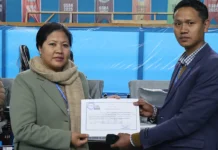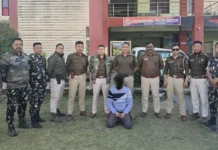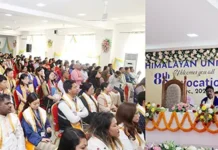ITANAGAR, 9 Nov: Youth-driven NGO Trigonometry concluded its 4th annual convention on Friday, carrying forward the theme ‘Footprints of responsibility’ through a three-day community service initiative across West Kameng district from 6-8 November.
The convention, which was led by Trigonometry representatives from West Kameng district, focused on educational support, environmental conservation, and community welfare through hands-on initiatives in rural areas. The three-day programme saw the team engaging with schools, communities, and local organisations across the district.
The convention began at Netaji Subhash Chandra Bose Avasiya Vidyalaya (NSCBAV) in Subu, Thrizino, where the volunteers implemented several programmes simultaneously. The team conducted a plantation drive for environmental conservation and created wildlife conservation wall paintings in collaboration with the Wildlife Trust of India at the school compound.
Addressing immediate infrastructure needs, they donated a 1,000-litre Sintex water tank and a steel storage rack to the school.
“We believe that real change happens when we work alongside communities, not just for them. Our members are self-funded young people who want to contribute to Arunachal’s development in practical, tangible ways,” said Trigonometry chairman Tobom Dai while briefing about the convention’s highlights.
Interactive sessions with schoolchildren were followed by a village community meeting and discussions with teachers and the School Management Committee to understand local challenges and opportunities. The team later gathered at Chug valley in Dirang for their general body meeting, reviewing the year’s activities and planning future initiatives.
The convention’s final stretch saw the team distributing winter clothing to students at Nyedo Choiling gonpa in Zimthung, Dirang, addressing the pressing need for warm clothing as winter sets in across the mountainous region.
At the gonpa, the team also met with monks and local panchayat leaders, discussing community needs and exploring opportunities for collaborative welfare initiatives. The interactions provided valuable insights into how traditional institutions and local governance can work together with youth organisations for community development.
The programme culminated with a visit to NSCBAV Shergaon, where Trigonometry members met with representatives of Garung Thuk, a pioneering local NGO that has been instrumental in Shergaon’s transformation into one of India’s best tourism villages.
Garung Thuk, which means ‘Our Village’ in Sherdukpen, was established in 2014 by forestry graduate Lobsang Tashi Thungon and his classmates with a focus on conserving the region’s rich biodiversity. The organisation manages initiatives like the Nature Interpretation Centre and the Cultural Interpretation Centre; has established a community library housing over 50,000 books; and conducts annual nature camps in the Eaglenest Wildlife Sanctuary.
Garung Thuk chairman Ledo Thungon and deputy chairman Dorjee K Thungon welcomed the Trigonometry team and shared their experiences in mobilising the Shergaon community around education, conservation, and ecotourism. The visiting team also explored the Garung Thuk library and interacted with children at NSCBAV Shergaon, exchanging ideas about youth mobilisation and community service.
Addressing the gathering at Shergaon, Dai said, “What you have achieved here at Garung Thuk is truly inspiring for all of us. You have shown how a community-driven approach can preserve culture while promoting sustainable development. These are the kinds of models we want to learn from and adapt in other parts of Arunachal.”
The Garung Thuk members expressed their happiness in meeting the Trigonometry team, with both organisations finding common ground in their commitment to grassroots development and youth engagement.
Informing about the group, Dai emphasised, “We’re building a network of young people across Arunachal who are committed to making a difference. This convention has reinforced that when youths take responsibility, real change becomes possible.”



